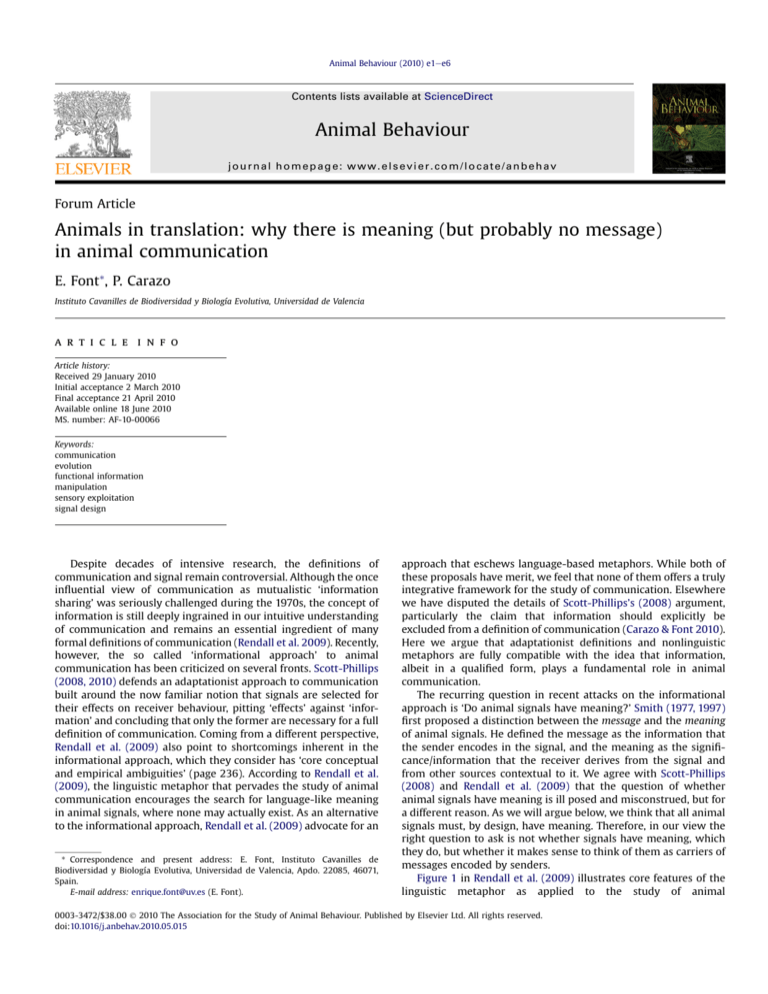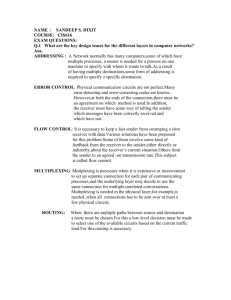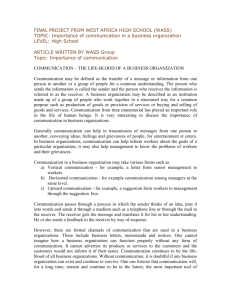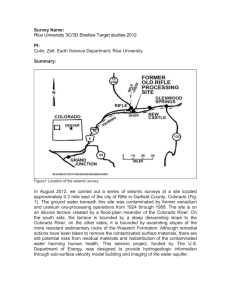
Animal Behaviour (2010) e1ee6
Contents lists available at ScienceDirect
Animal Behaviour
journal homepage: www.elsevier.com/locate/anbehav
Forum Article
Animals in translation: why there is meaning (but probably no message)
in animal communication
E. Font*, P. Carazo
Instituto Cavanilles de Biodiversidad y Biología Evolutiva, Universidad de Valencia
a r t i c l e i n f o
Article history:
Received 29 January 2010
Initial acceptance 2 March 2010
Final acceptance 21 April 2010
Available online 18 June 2010
MS. number: AF-10-00066
Keywords:
communication
evolution
functional information
manipulation
sensory exploitation
signal design
Despite decades of intensive research, the definitions of
communication and signal remain controversial. Although the once
influential view of communication as mutualistic ‘information
sharing’ was seriously challenged during the 1970s, the concept of
information is still deeply ingrained in our intuitive understanding
of communication and remains an essential ingredient of many
formal definitions of communication (Rendall et al. 2009). Recently,
however, the so called ‘informational approach’ to animal
communication has been criticized on several fronts. Scott-Phillips
(2008, 2010) defends an adaptationist approach to communication
built around the now familiar notion that signals are selected for
their effects on receiver behaviour, pitting ‘effects’ against ‘information’ and concluding that only the former are necessary for a full
definition of communication. Coming from a different perspective,
Rendall et al. (2009) also point to shortcomings inherent in the
informational approach, which they consider has ‘core conceptual
and empirical ambiguities’ (page 236). According to Rendall et al.
(2009), the linguistic metaphor that pervades the study of animal
communication encourages the search for language-like meaning
in animal signals, where none may actually exist. As an alternative
to the informational approach, Rendall et al. (2009) advocate for an
* Correspondence and present address: E. Font, Instituto Cavanilles de
Biodiversidad y Biología Evolutiva, Universidad de Valencia, Apdo. 22085, 46071,
Spain.
E-mail address: enrique.font@uv.es (E. Font).
approach that eschews language-based metaphors. While both of
these proposals have merit, we feel that none of them offers a truly
integrative framework for the study of communication. Elsewhere
we have disputed the details of Scott-Phillips’s (2008) argument,
particularly the claim that information should explicitly be
excluded from a definition of communication (Carazo & Font 2010).
Here we argue that adaptationist definitions and nonlinguistic
metaphors are fully compatible with the idea that information,
albeit in a qualified form, plays a fundamental role in animal
communication.
The recurring question in recent attacks on the informational
approach is ‘Do animal signals have meaning?’ Smith (1977, 1997)
first proposed a distinction between the message and the meaning
of animal signals. He defined the message as the information that
the sender encodes in the signal, and the meaning as the significance/information that the receiver derives from the signal and
from other sources contextual to it. We agree with Scott-Phillips
(2008) and Rendall et al. (2009) that the question of whether
animal signals have meaning is ill posed and misconstrued, but for
a different reason. As we will argue below, we think that all animal
signals must, by design, have meaning. Therefore, in our view the
right question to ask is not whether signals have meaning, which
they do, but whether it makes sense to think of them as carriers of
messages encoded by senders.
Figure 1 in Rendall et al. (2009) illustrates core features of the
linguistic metaphor as applied to the study of animal
0003-3472/$38.00 Ó 2010 The Association for the Study of Animal Behaviour. Published by Elsevier Ltd. All rights reserved.
doi:10.1016/j.anbehav.2010.05.015
e2
E. Font, P. Carazo / Animal Behaviour (2010) e1ee6
Influence receiver behaviour
Functional information
(Carazo & Font 2010)
(‘Effects’; Maynard Smith & Harper 2003;
Scott-Phillips 2008)
Manipulation
(Dawkins & Krebs 1978)
...arouse receiver, intimidate rival,
attract mate, keep out intruder,
repel predator...
...sender size, identity,
location, reproductive status,
parenting ability,
palatability...
SIGNAL
Receiver biases
Signal design
Information extraction
SENDER
(‘Mind-reading’, Krebs & Dawkins 1984; ‘Assessment’, Owings & Morton 1998)
RECEIVER
Figure 1. Schematic illustration of core features of the adaptationist approach to communication incorporating ‘functional information’. Here, information is not something
transmitted by senders but actively extracted by receivers, and it is precisely this ‘functional information’ being extracted that makes receiver response adaptive. The evolution of
a given signal may be driven by senders or receivers. It may begin, for example, with senders producing certain stimuli that manipulate receiver behaviour to their own advantage
(e.g. through sensory exploitation), or with receivers tapping on certain aspects of sender behaviour to extract information that is valuable to them. Irrespective of what happens
first, manipulation places receivers in a position to extract functional information from senders, while information extraction opens the opportunity for senders to use those
behaviours that are being ‘read’ to their own advantage. Thus, both ‘manipulation’ and ‘information extraction’ will feed back into each other, driving a coevolutionary dynamic that
will either end with the disappearance of the signal, or with its stabilization into a signal whose design features will reflect this ‘arms race’ between senders and receivers.
Information extraction is the ultimate aim of receivers to the same extent that influencing receiver behaviour is the ultimate aim of senders. Signal evolution and signal design
cannot be understood without acknowledging both strategies, and thus the concept of information is not only useful, but absolutely central to animal communication. Although we
have arbitrarily chosen two anurans to stand in as sender and receiver, the effects and functional information included in the example encompass a wide diversity of signalling
contexts.
communication. The figure shows two monkeys engaged in some
sort of ‘conversation’. A cognitive (internal) representation in the
mind of the sender is translated into a message whose content is
encoded in a signal and transmitted to the receiver. The receiver
receives the signal, decodes it, and recovers the message, which
then produces a corresponding representation in the receiver’s
mind. By analogy with human language, animal signals are
endowed with word-like properties, and communication is seen as
a deliberate attempt to invoke and manipulate conceptual representations in the minds of others (Rendall & Owren 2002).
Although Rendall et al.’s figure portrays rather well the way
communication is conceptualized by many students and nonspecialists, it is clearly a straw man. The linguistic metaphor has
intuitive appeal but the processes that govern information acquisition in most of human language and animal communication are
fundamentally different (Seyfarth & Cheney 2003). Many and
possibly all animal signals have meaning in the sense that they
make information available to receivers, but there are good reasons
to doubt whether signals ever encode messages in the sense outlined above. The current model of animal communication considers
that senders and receivers have different roles in communication
and, more importantly, are under different selection pressures.
Although both participate in the communicative act, the interaction
is adaptive for them for different reasons: senders obtain ‘effects’,
whereas receivers obtain ‘information’ (Carazo & Font 2010). ScottPhillips (2008) and Rendall et al. (2009) acknowledge the asymmetry between senders and receivers, but their proposals fail to
incorporate the essence of the communicative act: the trading of
information (about the sender or the environment) for effects
(receiver responses). As Seyfarth & Cheney (2003) and many others
before them have noted (e.g. Hennessy et al. 1981; Wiley 1983;
Krebs & Dawkins 1984; Harper 1991; Endler 1993; Hasson 1994,
2000; Johnstone 1997; Bradbury & Vehrencamp 1998; Owings &
Morton 1998; Maynard Smith & Harper 2003), selection favours
senders whose signals affect the behaviour of receivers to the
sender’s advantage, and selection favours receivers that are capable
of extracting useful information from the senders’ signals (Fig. 1). In
short, senders signal because they benefit from the effects accrued
by the signals’ influence on receivers (not because they want to
share information with them), whereas receivers respond to signals
because they benefit from the information they obtain about the
sender. Information sharing is not part of the senders’ aims, proximately or ultimately, and therefore receivers acquire information
from senders that do not intend to provide it (Owren & Rendall
1997, 2001; Seyfarth & Cheney 2003). There is meaning in animal
signals, but there probably is no message.
Inspired by the linguistic metaphor, it is easy to think of
communication as a transaction that involves the passing and
receiving of information. In Rendall et al.’s illustration, information
is seen as a commodity that flows from sender to receiver, the
signal being the vehicle for the transmission. The receiver in this
view is basically passive, ‘like a telephone waiting to be rung’
(Morton & Page 1992). Information is essential for communication
but its role differs from that suggested by the linguistic metaphor so
ably caricaturized by Rendall et al. (2009). The old view that
selection should act on senders to increase the efficiency of transmitting information for the benefit of senders and receivers has
been superseded by a framework centred on the coevolution of
selfish senders that signal strategically and equally selfish receivers
that extract whatever information they can from the communicative interaction. Many misunderstandings in the study of animal
communication may have been caused by the expression
E. Font, P. Carazo / Animal Behaviour (2010) e1ee6
‘information transfer/transmission’, which figures prominently in
several current definitions of communication. Communication
involves the transmission of signals, not information. It is simply
not correct to think of communication as information flowing from
sender to receiver (Owren & Rendall 2001). Most of the time, if not
always, information is not transferred or transmitted, but rather
extracted by receivers (often against the senders’ best interests),
whose role in the communicative dynamics is still underappreciated (Morton & Page 1992; Owings & Morton 1998).
If senders do not intend to inform receivers, why do they signal
in the first place? The answer has been around for several decades,
since Dawkins & Krebs (1978) introduced the idea of manipulation
to the study of animal communication. In this view, the function of
signalling is to influence receiver behaviour in a way that promotes
the fitness of the sender. Signals are thus traits whose specific
evolutionary benefit to senders stems from their potential to affect
the behaviour of others (Maynard Smith & Harper 1995; Hasson
2000). Using the logic of evolutionary game theory, Dawkins &
Krebs (1978) proposed that, in contrast to the ‘traditional ethological view’ (another straw man, see Smith 1986), selection should
act against senders that convey accurate information. Many have
taken this to imply that information has no place in communication. However, Dawkins & Krebs (1978) were not criticizing information itself, but rather the idea that information is transmitted
from senders to receivers in the way the codingedecoding scheme
suggests. In fact, in a later paper Krebs & Dawkins (1984) gave
receivers centre stage and contended that communication is the
result of a coevolutionary arms race between senders playing the
role of manipulators and receivers playing the role of mind-readers.
Krebs & Dawkins (1984) stressed the receiver’s ability to deduce
and anticipate the sender’s future behaviour (hence the expression
‘mind-reading’) but the argument has more generality and later
work has revealed that receivers can and indeed do obtain other
types of information about the sender, not just its intentions. Again,
it is expressions like ‘information transmission’ or ‘information
sharing’, not the concept of information, that are to be blamed for
generating confusion.
It has been argued that manipulation provides a plausible
scenario for the evolution of communication, but that it is not an
adequate explanation of communication at the proximate level
(Blumberg & Alberts 1997; Owings & Morton 1998). According to
this view, manipulative and information transmission accounts
would be complementary rather than alternative, with the former
addressing the evolutionary trade-offs involved and the latter
dealing with proximate mechanisms. After all, manipulation could
be accomplished by releasing information that is either false
(deceitful) or incomplete. However, recent research has revealed
that information transmission is not an adequate explanation of the
proximate mechanisms that underlie senders’ behaviour, and that
senders in general seem oblivious to the informational value of
their own signals as well as to the informational needs of their
potential receivers (Cheney & Seyfarth 1996; Rendall et al. 2000,
2009; Seyfarth & Cheney 2003). As Rendall et al. (2009, page 235)
put it, these findings ‘highlight an informational disconnection
between signallers and perceivers and suggest they do not share
the same representational parity that characterizes human speech’.
This is possibly one of the reasons why, compared to words, most
animal signals have rudimentary referential properties. Often, the
information obtained by the receiver refers to some property of the
sender or the sender’s behaviour (e.g. its needs, intentions, or
quality as a mate or as a competitor), but signals tend not to be very
informative about other potential referents that could be relevant
for receivers (Smith 1977; Hasson 1997).
Rendall et al. (2009) suggest replacing the traditional emphasis
on information for an emphasis on the influence exerted by senders
e3
on receivers (i.e. senders affect/influence/manipulate the behaviour
of receivers rather than inform them). This proposal rests on the
assumption that manipulation and information are mutually
exclusive alternatives. In fact, the two are fully compatible as long
as we keep in mind that information is not intentionally made
available by the sender, as in the linguistic metaphor, but rather
extracted by the receiver (see also Wiley 1983; Smith 1986). There
is abundant evidence that unintended receivers can and do extract
information from a communicative interaction, a phenomenon
known as eavesdropping. Eavesdropping comes at a significant cost
to senders and has been described in many taxa (McGregor 1993,
2005). Similarly, several studies have shown that bystanders
acquire information by being present at but not involved in
aggressive interactions (Dugatkin 2001). As Seyfarth & Cheney
(2003) point out, it does not seem a logical position to grant the
acquisition of information to bystanders and deny it to the signaller’s intended receivers.
If not by deliberately coding information valuable to receivers,
how can senders influence the behaviour of receivers? How do
signals achieve their effects? Rendall et al. (2009) point out that
many signals appear to be designed to achieve their effects directly
by tapping into basic perceptual, neuroendocrine and psychological
processes of receivers (see also Guilford & Dawkins 1991; Arak &
Enquist 1993, 1995; Christy 1995). The design features of many
signals make them ideally suited to attract the receiver’s attention,
induce arousal, and/or evoke conditioned or unconditioned
reflexive affective responses. In other words, signals are designed
so that receivers cannot simply choose to ignore them. For example,
vocalizations such as an infant’s cry may be effective simply
because their acoustic properties make them aversive to receivers
and difficult to habituate to (Owings & Zeifman 2004). That the
alarm calls of many birds and mammals have similar acoustic
properties and elicit similar orienting and flight preparation
behaviours in receivers, also points to shared, perhaps ancestral
mechanisms whereby sounds of certain characteristics trigger
specific responses in receivers. Most of the examples provided by
Rendall et al. (2009) have to do with vocalizations, but the same
principles apply to signals in other sensory modalities. Many visual
signals, for example, are designed to maximally stimulate the visual
system of receivers (Stevens 2005, 2007; Stevens et al. 2008).
Scott-Phillips (2008) and Rendall et al. (2009) are not alone in
their plea to ban information from the study of communication.
Since its introduction to the study of animal communication in the
1950s, the concept of information has been an endless source of
confusion and misunderstanding, and there have been several
proposals to do away with it (Owings & Morton 1997, 1998; Owren
2000). This may be due at least in part to the uneasy coexistence of
two meanings of information: technical and semantic (e.g. Krebs &
Dawkins 1984; Markl 1985; Owings & Morton 1998). The two
address different aspects of the communicative process. Information in the technical sense is reduction in the uncertainty (to an
external observer) caused by the sending of a signal. Wiley (1983)
further distinguishes between ‘broadcast’ and ‘transmitted’ technical information. Broadcast information is an observer’s reduction
in uncertainty about the sender’s behaviour caused by a signal,
whereas transmitted information is reduction in uncertainty about
the receiver’s behaviour. Semantic or ‘colloquial’ sense information
(Dawkins 1995; Maynard Smith & Harper 1995), on the other hand,
attempts to characterize the content or ‘aboutness’ of animal
signals (i.e. that property of the sender or its environment that
signals are about). Technical and semantic information are concerned with different levels of semiotic analysis: technical information is concerned with the syntactic level of analysis, whereas
semantic information, as the name implies, corresponds to the
semantic level.
e4
E. Font, P. Carazo / Animal Behaviour (2010) e1ee6
Technical information had its origin in the field of electrical
engineering as a quantitative measure of the amount of information (measured in bits) that can be encoded and transmitted efficiently through a given channel. Technical information has the
appeal of a rigorous mathematical theory. However, its application
to animal communication is beset with difficulties. First, there is
the problem of specifying the behavioural options available to
senders and receivers (and their associated probabilities). Unless
our partitioning of the behaviour stream into discrete units agrees
with the way the animals themselves partition behaviour, we are
bound to come up with meaningless estimates of uncertainty
reduction. If, for example, the animals divide up behaviour into
more units than the observer, the amount of uncertainty reduced
by the signal may be underestimated (Krebs & Dawkins 1984). A
second problem with the technical meaning of information is
receiver relativity: in order to determine how much uncertainty is
reduced by the reception of a signal, we need to know what the
receiver (not the external observer) already knew about the sender
or its environment before the signal was produced. Thus, the
amount of technical information transmitted is determined at least
in part by the receiver (Scott-Phillips 2008). Finally, there is the
problem of referential indeterminacy (Quine 1960). Technical
information focuses on one of the consequences of information
transmission (i.e. uncertainty is reduced), but it does not give an
explicit account of what specific signals are about. Technical
information is content-neutral (Dennett 1987) or content-free (Di
Paolo 1997), and therefore indifferent to the kinds of information
(in the semantic sense) provided by a given signal.
This last point has generated the most misunderstanding.
Several authors have attempted to reconcile the two meanings of
information by pointing out how one can easily go from technical to
semantic information and vice versa (Wiley 1983; Krebs & Dawkins
1984; Hasson 1994; Smith 1997). A signal that reduces the
receiver’s uncertainty about some feature of the sender or the
environment (technical information) can be viewed as a source of
semantic information about that particular feature. As Allen &
Hauser (1992) explain, ‘this may seem to provide a notion of
[semantic] content since it helps to characterize what a given signal
is about’ (page 84). The equivalence/correspondence, however, is
illusory: technical information provides a measure of the amount of
information, but it does not specify the type of information (in the
semantic sense) transmitted.
By definition, all signals transmit technical information (i.e.
reduce uncertainty), but some signals may reduce the receiver’s
uncertainty about trivial and uninteresting aspects of the sender or
the environment (Scott-Phillips 2008). Imagine a male uttering
a string of territorial calls. The nth call may convey as much
semantic information (‘I’m a territorial male in full reproductive
mode’) as the first, but it will not further reduce the uncertainty of
a receiver that has already listened to the n 1 previous calls. The
information (in the semantic sense) that the sender is a territorial
male is not news to the receiver and therefore her uncertainty in
that respect is not reduced by the male’s call. Thus, signalling will
have resulted in a reduction in the receiver’s uncertainty (e.g. about
the fact that the receiver is still alive and has not changed sex), but
not about those features that actually drove the evolution of the
signal because the latter were already known to the receiver.
This is not to say that the concept of technical information has
no use in the study of animal communication (see, for example:
Rand & Williams 1970; McCowan et al. 2002), but most authors
consider it inadequate for understanding the selective pressures
acting on senders and receivers. Information as uncertainty
reduction ‘rarely encapsulates all of the important qualities of
information from a whole-organism perspective’ (Dall et al. 2005,
pp. 187e188). It is telling that many papers and book chapters on
communication devote considerable space to the definition and
measurement of technical information, only to conclude that the
concept of information implied in most discussions of communication is semantic, not technical information (Wiley 1983; Krebs &
Dawkins 1984; Dawkins 1995; Maynard Smith & Harper 1995;
Barnard 2004). However, semantic information is not free from
criticisms. In fact, both meanings of information, technical and
semantic, are considered too broad for a rigorous analysis of
communication (Carazo & Font 2010), which is the main reason
why information as currently construed cannot be a central
defining property of communication. For example, animals often
obtain information from sources other than signals, including
direct assessment, cues, prior probabilities (Bradbury &
Vehrencamp 1998), and even signalling components of nonsignalling behaviours (Lotem et al. 1999).
In an effort to accommodate information within the adaptationist framework of communication, we have proposed yet
another meaning of information. Functional information is the
attribute or attributes of the sender and/or the environment that
correlate with one or several characteristics in the design of a signal
and are responsible for the evolution (or maintenance) of the
response to that signal (Carazo & Font 2010). Functional information is whatever information (in the semantic sense) can be
extracted from the communicative exchange that makes it adaptive
for the receiver to respond to a given signal. Functional information
is thus the subset of semantic information that encompasses those
features of the sender or the environment that allow the receiver to
make informed decisions that improve its fitness. Note that here we
are using the term ‘functional’ in the strictly Tinbergian sense of
adaptive value. Recently, ‘functional’ has also been used as a device
to avoid potentially awkward implications of intentionality in
discussions of nonhuman animal behaviour (e.g. functional referentiality, functional deception, functional altruism). Functional
deception, for example, is behaviour that ‘has the effects of
deception without necessarily having the cognitive underpinnings
that we would require of deception in humans’ (Searcy & Nowicki
2005, page 5). This meaning of functional is different from the
one we use here.
If a signal is to be effective in eliciting the appropriate response,
it must make functional information available to receivers. For
example, a female that hears a male’s call will know that
a conspecific male is nearby, and may also be able to learn something about the male’s size, age, physical condition or quality as
a potential mate. If the information acquired by the receiver more
than outweighs the costs involved in sensing, processing and
responding to the signal, then we have a potentially stable
communication system. If no functional information is available,
receivers will evolve counterstrategies and coevolution between
sender and receiver will proceed until signals disappear or an
equilibrium that benefits both parties is reached (Moynihan 1970;
Bradbury & Vehrencamp 1998). The concept of functional information allows us to formulate a definition of a communicative
signal that nicely synthesizes adaptationist and informational
approaches as ‘any act or structure that (1) affects the behaviour of
other organisms; (2) evolved (or is maintained) because of those
effects; (3) is effective because it makes functional information
available to receivers (i.e. it allows receivers to extract functional
information)’ (Carazo & Font 2010). This definition deliberately
leaves out deceptive signals (i.e. cases in which signals do not make
functional information available to receivers; e.g. aggressive
mimicry, false alarm calls). However, this does not mean that
deceptive signals should be excluded from the study of communication (Carazo & Font 2010). From the receiver’s perspective, honest
and deceptive signals are one and the same, both proximally
(because their structure is sufficiently similar that discriminating
E. Font, P. Carazo / Animal Behaviour (2010) e1ee6
between them is beyond the receiver’s perceptual abilities) and at
the ultimate level (because honest and deceptive instances of the
signal are part of a signalling system that favours receiver responses
to signals that are ‘honest on average’; Johnstone & Grafen 1993;
Kokko 1997). For example, male armyworm moths respond to the
chemical released by bolas spiders because they cannot differentiate between it and the pheromone emitted by female moths and
because, on average, they benefit more from approaching the
source of the chemical than from ignoring it (Maynard Smith &
Harper 1995). Honest and deceptive signals are key elements of
the same signalling system, but the concept of ‘functional information’ allows us to distinguish between two types of signals that
are the result of different underlying evolutionary processes
(Carazo & Font 2010). From the sender’s perspective, honest signals
work because they make functional information available to
receivers (otherwise, receivers would not respond); deceptive
signals, on the other hand, are effective because others (i.e. the
honest senders) make functional information available to receivers.
An example may help clarify some of the conceptual issues
discussed above. Lateral or broadside displays are common in
agonistic encounters between rival males in many taxa (Chiszar
1978; see examples in Bradbury & Vehrencamp 1998, page 509).
An animal performing a lateral display orients itself in such a way
that it presents its lateral aspect to its opponent. Two explanations
are available to account for the evolutionary origins of such
a display. According to classical ethological lore, displays evolve
from nonsignalling behaviours that give away information of use to
receivers. Not surprisingly, among such protosignals are intention
movements such as those preceding the execution of specific
actions (Tinbergen 1952). Lateral displays in particular are believed
to have evolved from the blending of antithetical intention movements of escape and attack. Given such evolutionary origins, early
ethologists reasonably interpreted lateral displays as signals that
allow receivers to assess the sender’s current motivational state
(Baerends 1975). An alternative explanation focuses instead on the
sender and its ability to manipulate receivers by exploiting latent
sensory or neural biases. Big things are potentially more dangerous
than small things, and many animals seem to follow the rule of
thumb ‘bigger is meaner’ in their interactions with members of
their own or a different species. As animals engaged in a lateral
display project a larger image onto the retinas of others with which
they interact than animals that adopt alternative body orientations,
lateral displays should be more intimidating to rivals and thus
selection should favour senders that perform lateral rather than
other types of displays. Of course, the evidence to choose among
these alternative scenarios will be lacking in most cases, but the
important point is that the two explanations are not mutually
exclusive. Even if the signal initially arose from sender manipulation of receiver biases, selection should favour receivers that
benefit from the interaction. One obvious way that receivers can
benefit is to obtain information (functional information) about the
sender. This can be information about the sender’s motivational
state or probability of attack, as surmised by classical ethologists, or
about its body size or any other attribute that may relate to its
competitive ability as proposed by modern adaptationists.
Often two opponents face each other laterally in a reciprocal
lateral display, adopting either a parallel (head to head) or antiparallel (head to tail) orientation. Examples include the lateral
displays of many fish and lizard species, and the parallel walk in red
deer stags. The standard line holds that the function of reciprocal
lateral displays is to allow opponents to assess their relative body
size and reveal possible size asymmetries between them. Even such
an apparently harmless statement can be misleading if care is not
taken to distinguish the roles of sender and receiver. The statement
is potentially misleading because it suggests that, as senders, the
e5
participants in an aggressive interaction intentionally release
information regarding their body size. It suggests that each animal
in the interaction benefits, as a sender, from making information
available to receivers. In fact, information about a rival’s size is the
benefit each participating animal derives, as receiver, from
the interaction. The display works because it intimidates rivals, and
the mechanisms whereby that effect is achieved probably have
little to do with the voluntary provision of information. Of course,
the distinction between the benefits accruing to senders and
receivers may seem artificial because both animals participating in
the interaction are at the same time senders and receivers. But the
distinction is important for a correct understanding of the evolutionary dynamics involved.
During lateral displays it is fairly common for animals to enlarge
their lateral profile by some sort of body compression in the sagittal
plane. Sagittal compression has been interpreted as a result of the
animal ‘trying to make itself look bigger’. In fact, from the sender’s
perspective sagittal compression works not because it misrepresents the animal’s true size but because it projects a larger image
onto the receiver’s retina and is thus more intimidating to receivers
that abide by the ‘bigger is meaner’ rule. It is easy to imagine how
such a trait could evolve: in a population in which every individual
is performing lateral displays, a mutant that increased its apparent
size through sagittal compression would enjoy an immediate
fitness advantage. The signal then becomes deceptive to receivers
because sagittal compression distorts the relationship between the
sender’s lateral profile and its actual body size. The term ‘exaggerator’ was proposed by Maynard Smith & Harper (2003) for those
features, like sagittal compression, that increase the apparent size
of a structure. Once they arise, exaggerators will rapidly be adopted
by all the members of a population. If sagittal compression really
works, in the sense of making the displaying individual a more
intimidating adversary, selection will soon result in all individuals
doing the new trick. When this happens, the exaggerator becomes
an index, a signal that is unfakeable due to physical constraints
(Maynard Smith & Harper 2003). The first individuals to perform
sagittal compression were exaggerating their apparent size; now,
however, every individual in the population is doing it and, as long
as there is a close relationship between the sender’s maximum
attainable profile and its true size, the signal will again be reliable
(Hasson 1997). At this point, receivers may be able to extract other
types of information about the sender, in addition to its motivational state or body size. In iguanian lizards, for example, sagittal
compression is thought to hinder breathing, thereby handicapping
the performing lizard (Brandt 2003). Thus, the time that an individual spends in sagittal compression could act as a quality handicap (Hasson 1997) reflecting endurance capacity, which in turn is
related to fighting ability.
Once everybody is using sagittal compression as part of their
lateral displays, the stage is set for a new round of coevolutionary
arms race, one involving additional acts or structures that increase
the apparent size of the displaying animal even further, such as
raised hackles, fluffed up feathers, erected crests and extended fins.
Some of these traits will initially be exaggerators of body size, but
as selection tends to fix them in the population they will also turn
into indices, perhaps providing other types of functional information to receivers. Although the specific details may be speculative,
the bottom line is that information is important at every stage in
the evolution of this signalling system, even though we risk missing
it by an exclusive focus on signal effects and on the benefits reaped
by senders (Scott-Phillips 2008). On a proximate level, information
allows receivers to make informed decisions; on an ultimate level,
it is the reason why receivers respond to signals. Manipulation and
information are fully compatible as long as we take account of the
two-pronged nature of communication and the different selection
e6
E. Font, P. Carazo / Animal Behaviour (2010) e1ee6
pressures acting on senders and receivers. The integration of these
two evolutionary mechanisms provides a general theory that
explains the evolution of animal communicative signals, and the
concept of functional information is fundamental to this aim.
We thank Matthew Kramer, Drew Rendall and two anonymous
referees for their insightful comments and detailed revision of our
manuscript.
References
Allen, C. & Hauser, M. 1992. Communication and cognition: is information the
connection? Yearbook of the Philosophy of Science, 2, 81e91.
Arak, A. & Enquist, M. 1993. Hidden preferences and the evolution of signals.
Philosophical Transactions of the Royal Society of London, Series B, 340, 207e213.
Arak, A. & Enquist, M. 1995. Conflict, receiver bias and the evolution of signal form.
Philosophical Transactions of the Royal Society of London, Series B, 349, 337e344.
Baerends, G. P. 1975. An evaluation of the conflict hypothesis as an explanatory
principle for the evolution of displays. In: Function and Evolution of Behaviour (Ed.
by G. Baerends, C. Beer & A. Manning), pp. 187e228. Oxford: Clarendon Press.
Barnard, C. 2004. Animal Behaviour: Mechanism, Development, Ecology and Evolution. Harlow, Essex: Pearson & Prentice Hall.
Blumberg, M. S. & Alberts, J. R. 1997. Incidental emissions, fortuitous effects, and
the origin of communication. In: Perspectives in Ethology. Vol. 12: Communication
(Ed. by D. H. Owings, M. D. Beecher & N. S. Thompson), pp. 225e249. New York:
Plenum.
Bradbury, J. W. & Vehrencamp, S. L. 1998. Principles of Animal Communication.
Sunderland, Massachusetts: Sinauer.
Brandt, Y. 2003. Lizard threat display handicaps endurance. Proceedings of the Royal
Society B, 270, 1061e1068.
Carazo, P. & Font, E. 2010. Putting information back into biological communication.
Journal of Evolutionary Biology, 23, 661e669.
Cheney, D. L. & Seyfarth, R. M. 1996. Function and intention in the calls of
nonhuman primates. Proceedings of the British Academy, 88, 59e76.
Chiszar, D. 1978. Lateral displays in the lower vertebrates: forms, functions, and
origins. In: Contrasts in Behavior. Adaptations in the Aquatic and Terrestrial
Environments (Ed. by S. Reese & F. J. Lighter), pp. 105e135. New York: J. Wiley.
Christy, J. H. 1995. Mimicry, mate choice, and the sensory trap hypothesis. American
Naturalist, 146, 171e181.
Dall, S. R. X., Giraldeau, L.-A., Olsson, O., McNamara, J. M. & Stephens, D. W. 2005.
Information and its use by animals in evolutionary ecology. Trends in Ecology
and Evolution, 20, 187e193.
Dawkins, M. S. 1995. Unravelling Animal Behaviour, 2nd edn. Harlow, Essex:
Longman.
Dawkins, R. & Krebs, J. R. 1978. Animal signals: information or manipulation. In:
Behavioural Ecology: an Evolutionary Approach (Ed. by J. R. Krebs & N. B. Davies),
pp. 282e309. Oxford: Blackwell.
Dennett, D. C. 1987. The Intentional Stance. Cambridge, Massachusetts: MIT Press.
Di Paolo, E. A. 1997. An investigation into the evolution of communication. Adaptive
Behavior, 6, 285e324.
Dugatkin, L. A. 2001. Bystander effects and the structure of dominance hierarchies.
Behavioral Ecology, 12, 348e352.
Endler, J. A. 1993. Some general comments of the evolution and design of animal
communication systems. Philosophical Transactions of the Royal Society of London, Series B, 340, 215e225.
Guilford, T. & Dawkins, M. S. 1991. Receiver psychology and the evolution of animal
signals. Animal Behaviour, 42, 1e14.
Harper, D. G. C. 1991. Communication. In: Behavioural Ecology: an Evolutionary
Approach (Ed. by J. R. Krebs & N. B. Davies), 3rd edn. Oxford: Blackwell.
Hasson, O. 1994. Cheating signals. Journal of Theoretical Biology, 167, 223e238.
Hasson, O. 1997. Towards a general theory of biological signaling. Journal of
Theoretical Biology, 185, 139e156.
Hasson, O. 2000. Knowledge, information, biases and signal assemblages. In:
Animal Signals: Signalling and Signal Design in Animal Communication (Ed. by
Y. Espmark, T. Amundsen & G. Rosenqvist), pp. 445e463. Trondheim, Norway:
Tapir Academic Press.
Hennessy, D. F., Owings, D. H., Rowe, M. P., Coss, R. G. & Leger, D. W. 1981. The
information afforded by a variable signal: constraints on snake-elicited tail
flagging by California ground squirrels. Behaviour, 78, 188e226.
Johnstone, R. A. 1997. The evolution of animal signals. In: Behavioural Ecology: an
Evolutionary Approach (Ed. by J. R. Krebs & N. B. Davies), pp. 155e178, 4th edn.
Oxford: Blackwell.
Johnstone, R. A. & Grafen, A. 1993. Dishonesty and the handicap principle. Animal
Behaviour, 46, 759e764.
Kokko, H. 1997. Evolutionarily stable strategies of age-dependent sexual advertisement. Behavioral Ecology and Sociobiology, 41, 99e107.
Krebs, J. R. & Dawkins, R. 1984. Animal signals: mind-reading and manipulation.
In: Behavioural Ecology: an Evolutionary Approach (Ed. by J. R. Krebs &
N. B. Davies), pp. 380e402, 2nd edn. Oxford: Blackwell.
Lotem, A., Wagner, R. H. & Balshine-Earn, S. 1999. The overlooked signaling
component of nonsignaling behavior. Behavioral Ecology, 10, 209e212.
McCowan, B., Doyle, L. R. & Hanser, S. F. 2002. Using information theory to assess
the diversity, complexity, and development of communicative repertoires.
Journal of Comparative Psychology, 116, 166e172.
McGregor, P. K. 1993. Signalling in territorial systems: a context for individual
identification, ranging and eavesdropping. Philosophical Transactions of the
Royal Society of London, Series B, 340, 237e244.
McGregor, P. K. 2005. Animal Communication Networks. Cambridge: Cambridge
University Press.
Markl, H. 1985. Manipulation, modulation, information, cognition: some of the
riddles of communication. In: Experimental Behavioral Ecology and Sociobiology
(Ed. by B. Holldobler & M. Lindauer), pp.163e194. Stuttgart: Gustav Fischer Verlag.
Maynard Smith, J. & Harper, D. G. C. 1995. Animal signals: models and terminology. Journal of Theoretical Biology, 177, 305e311.
Maynard Smith, J. & Harper, D. G. C. 2003. Animal Signals. Oxford: Oxford
University Press.
Morton, E. S. & Page, J. 1992. Animal Talk: Science and the Voices of Nature. New
York: Random House.
Moynihan, M. 1970. Control, suppression, decay, disappearance and replacement of
displays. Journal of Theoretical Biology, 29, 85e112.
Owings, D. H. & Morton, E. S. 1997. The role of information in communication: an
assessment/management approach. In: Perspectives in Ethology. Vol. 12:
Communication (Ed. by D. H. Owings, M. D. Beecher & N. S. Thompson), pp.
359e390. New York: Plenum.
Owings, D. H. & Morton, E. S. 1998. Animal Vocal Communication: a New Approach.
Cambridge: Cambridge University Press.
Owings, D. H. & Zeifman, D. M. 2004. Human infant crying as an animal
communication system: insights from an assessment/management approach.
In: Evolution of Communication Systems: a Comparative Approach (Ed. by
D. K. Oller & U. Griebel), pp. 151e170. Cambridge, Massachusetts: MIT Press.
Owren, M. J. 2000. Standing evolution on its head: the uneasy role of evolutionary
theory in comparative cognition and communication. Reviews in Anthropology,
29, 55e69.
Owren, M. J. & Rendall, D. 1997. An affect-conditioning model of nonhuman primate
vocalizations. In: Perspectives in Ethology. Vol. 12: Communication (Ed. by
D. H. Owings, M. D. Beecher & N. S. Thompson), pp. 299e346. New York: Plenum.
Owren, M. J. & Rendall, D. 2001. Sound on the rebound: returning form and
function to the forefront in understanding nonhuman primate vocal signaling.
Evolutionary Anthropology, 10, 58e71.
Quine, W. V. O. 1960. Word and Object. Cambridge, Massachusetts: MIT Press.
Rand, A. S. & Williams, E. E. 1970. An estimation of redundancy and information
content of anole dewlaps. American Naturalist, 104, 99e103.
Rendall, D. & Owren, M. J. 2002. Animal vocal communication: say what? In: The
Cognitive Animal (Ed. by M. Bekoff, C. Allen & G. Burghardt), pp. 307e314.
Cambridge, Massachusetts: MIT Press.
Rendall, D., Cheney, D. L. & Seyfarth, R. M. 2000. Proximate factors mediating
‘contact’ calls in adult female baboons and their infants. Journal of Comparative
Psychology, 114, 36e46.
Rendall, D., Owren, M. J. & Ryan, M. J. 2009. What do animal signals mean? Animal
Behaviour, 78, 233e240.
Scott-Phillips, T. C. 2008. Defining biological communication. Journal of Evolutionary Biology, 21, 387e395.
Scott-Phillips, T. C. 2010. Animal communication: insights from linguistic pragmatics. Animal Behaviour, 79 (1), e1ee4.
Searcy, W. A. & Nowicki, S. 2005. The Evolution of Animal Communication: Reliability
and Deception in Signaling Systems. Princeton, New Jersey: Princeton University
Press.
Seyfarth, R. M. & Cheney, D. L. 2003. Signallers and receivers in animal communication. Annual Review of Psychology, 54, 145e173.
Smith, W. J. 1977. The Behavior of Communicating: an Ethological Approach. Cambridge, Massachusetts: Harvard University Press.
Smith, W. J. 1986. An ‘informational’ perspective on manipulation. In: Deception,
Perspectives on Human and Nonhuman Deceit (Ed. by R. W. Mitchell &
N. S. Thompson), pp. 71e86. New York: State University of New York Press.
Smith, W. J. 1997. The behavior of communicating, after twenty years. In:
Perspectives in Ethology. Vol. 12: Communication (Ed. by D. H. Owings,
M. D. Beecher & N. S. Thompson), pp. 7e53. New York: Plenum.
Stevens, M. 2005. The role of eyespots as anti-predator mechanisms, principally
demonstrated in the Lepidoptera. Biological Reviews, 80, 573e588.
Stevens, M. 2007. Predator perception and the interrelation between different
forms of protective coloration. Proceedings of the Royal Society B, 274,
1457e1464.
Stevens, M., Hardman, C. J. & Stubbins, C. L. 2008. Conspicuousness, not eye
mimicry, makes ‘eyespots’ effective antipredator signals. Behavioral Ecology, 19,
525e531.
Tinbergen, N. 1952. ‘Derived’ activities; their causation, biological significance,
origin, and emancipation during evolution. Quarterly Review of Biology, 27,
1e32.
Wiley, R. H. 1983. The evolution of communication: information and manipulation.
In: Animal Behaviour. Vol. 2: Communication (Ed. by T. R. Halliday & P. J. B. Slater),
pp. 156e189. Oxford: Blackwell.








